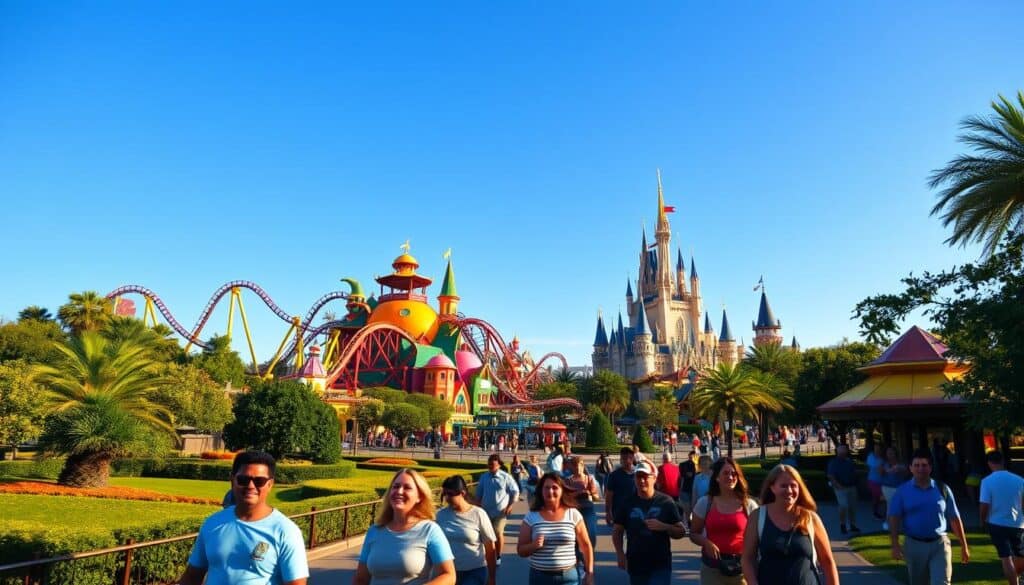Step into a realm of magic and adventure where every corner holds a new story waiting to be discovered. From thrilling coasters to immersive storytelling, the resort offers something for everyone. Whether you’re soaring through the stars on Space Mountain or exploring the high seas with Pirates of the Caribbean, the excitement never ends.
Classic rides like Big Thunder Mountain continue to captivate visitors, while newer additions like Avatar Flight of Passage bring cutting-edge technology to life. The resort constantly evolves, ensuring every visit feels fresh and exciting. For instance, the recent transformation of Splash Mountain into a new adventure highlights its commitment to innovation.
Families, thrill-seekers, and dreamers alike will find endless joy here. This guide will help you navigate the best rides, share insider tips, and make the most of your visit. Get ready to create memories that will last a lifetime!
Key Takeaways
- Explore a mix of classic and modern rides for all ages.
- Experience iconic attractions like Space Mountain and Pirates of the Caribbean.
- Discover cutting-edge adventures such as Avatar Flight of Passage.
- Stay updated on new additions and transformations.
- Plan your visit with practical tips and ride recommendations.
Introduction to the Magic of Disney World
Discover a place where dreams come alive and every moment feels like magic. With four distinct theme parks, each offering its own unique charm, this destination is a treasure trove of unforgettable experiences. From thrilling rides to enchanting character encounters, there’s something for everyone to enjoy.
Magic Kingdom, Epcot, Hollywood Studios, and Animal Kingdom each bring their own flavor of adventure. Whether you’re exploring the futuristic wonders of Epcot or the wild landscapes of Animal Kingdom, every park promises a new journey. The recently added Tron Lightcycle Run is a must-see, blending cutting-edge technology with heart-pounding excitement.
Iconic characters like Mickey and Minnie add a touch of nostalgia, making every visit feel special. Attractions are thoughtfully organized into themes, ensuring a seamless blend of action-packed rides and family-friendly fun. Over the years, the parks have evolved, introducing new experiences while preserving beloved classics.
This magical destination continues to innovate, offering a mix of timeless charm and modern thrills. Whether you’re a first-time visitor or a seasoned traveler, the enchantment never fades. Get ready to embark on a journey that blends the past, present, and future into one unforgettable adventure.
Insider Tips for Planning Your Disney Adventure
Make the most of your visit with smart planning and insider tips. A well-organized day can help you experience more while avoiding long waits. From early arrival strategies to using Lightning Lanes, these tips will ensure your adventure is seamless and enjoyable.
Early Arrival and Entry Strategies
Arriving early is one of the best ways to beat the crowds. Parks often open before the official start time, allowing early birds to enjoy popular rides with minimal wait. For resort guests, early entry privileges provide even more time to explore.
Plan to be at the gates at least 30 minutes before opening. This gives you a head start on attractions like Space Mountain or Avatar Flight of Passage. Use this time to map out your day and prioritize must-see experiences.
Maximizing Your Visit with Lightning Lanes
Lightning Lanes are a game-changer for efficient park navigation. These passes allow you to skip long lines and enjoy prioritized access to top attractions. For example, rides like Toy Story Mania and TRON Lightcycle Run are perfect candidates for this service.
Here’s a quick breakdown of Lightning Lane costs:
| Pass Type | Cost (Per Person) |
|---|---|
| Multi-Lightning Lane | $15-$25 |
| Single Lightning Lane | $10-$30 |
Balance your day by combining Lightning Lanes with immersive shows and themed experiences. This ensures you make the most of your time without feeling rushed. Check park maps and schedules to align your plans with operational updates.
By following these strategies, you’ll create a well-organized and unforgettable adventure. Whether it’s your first visit or your tenth, these tips will help you enjoy every moment to the fullest.
Exploring Classic Attractions at Magic Kingdom
Magic Kingdom is a treasure trove of timeless experiences that blend nostalgia with modern thrills. From iconic rides to enchanting parades, this park offers something for everyone. Whether you’re a first-time visitor or a seasoned traveler, the charm of its classic attractions never fades.

Iconic Rides and Timeless Experiences
No visit to Magic Kingdom is complete without experiencing its legendary rides. Big Thunder Mountain Railroad remains a fan favorite, offering a wild ride through the Old West. Its recent refurbishments have added new life to this classic, blending tradition with cutting-edge technology.
For those seeking thrills, Space Mountain delivers a high-speed journey through the stars. Meanwhile, Pirates of the Caribbean immerses visitors in a swashbuckling adventure filled with animatronics and storytelling. These rides showcase the park’s ability to balance nostalgia with innovation.
Character Encounters and Parades
Meeting beloved characters is a highlight for many visitors. From Mickey Mouse to Princess Tiana, these encounters create magical memories. Scheduled meet-and-greet times ensure fans can interact with their favorite icons in an immersive environment.
Parades add another layer of excitement. The vibrant floats and lively performances bring stories to life. “There’s nothing quite like the joy of seeing your favorite characters up close,” says one visitor. These events are a must-see for families and fans alike.
To make the most of your visit, pace yourself. Combine iconic rides with live entertainment for a well-rounded experience. Whether you’re exploring thunder mountain or enjoying a parade, Magic Kingdom promises unforgettable moments.
Thrill Rides and Family Favorites to Experience
From heart-pounding roller coasters to gentle family rides, there’s something for everyone to enjoy. Whether you’re seeking adrenaline or a relaxing adventure, the parks offer a perfect mix of excitement and fun for all ages.
Adrenaline-Pumping Coasters
For thrill-seekers, the parks are home to some of the most exhilarating rides. Cosmic Rewind takes you on a high-speed journey through space, combining cutting-edge technology with immersive storytelling. It’s a must-try for anyone who loves a good roller coaster.
Another fan favorite is the Tower of Terror, where you’ll experience sudden drops and unexpected twists. The ride’s unique sequence ensures no two experiences are the same, making it a thrilling adventure every time.
If you’re a fan of classic coasters, Big Thunder Mountain delivers a wild ride through the Old West. Its recent updates have added new life to this beloved attraction, blending tradition with modern engineering.
Kid-Friendly Rides for All Ages
Families with younger children will find plenty of options to enjoy together. Gentle rides like Seven Dwarfs Mine Train offer a mix of fun and excitement, perfect for younger riders. Its smooth twists and turns make it a family favorite.
For a magical experience, Peter Pan’s Flight takes you soaring through Neverland. Its enchanting storytelling and vibrant scenes captivate both kids and adults alike.
Here’s a quick guide to height requirements for popular rides:
| Ride | Minimum Height |
|---|---|
| Cosmic Rewind | 42 inches |
| Tower of Terror | 40 inches |
| Big Thunder Mountain | 40 inches |
| Seven Dwarfs Mine Train | 38 inches |
Planning your day around these rides can help minimize wait times and maximize fun. Arrive early for popular attractions and consider using Lightning Lanes for a smoother experience.
Whether you’re chasing thrills or enjoying a leisurely ride, the parks offer unforgettable experiences for everyone. From cosmic rewind adventures to family-friendly fun, there’s no shortage of excitement to explore.
Immersive Themes and Storytelling in Disney Attractions
Immerse yourself in a world where storytelling and technology come together to create unforgettable experiences. Every ride is a journey, blending cinematic magic with cutting-edge innovation. From futuristic adventures to expedition-style thrills, the attractions are designed to captivate and inspire.

Experiences Inspired by Beloved Films
Attractions like Tron Lightcycle take you into the heart of a movie universe. This ride combines futuristic elements with classic film inspirations, creating a thrilling experience for all ages. Families and kids alike will love the immersive storytelling that brings these adventures to life.
Another standout is Expedition Everest, which transports you to the Himalayas. This ride blends high-tech design with a rich narrative, making it a favorite for thrill-seekers. The attention to detail in the theming ensures every moment feels real and exciting.
“The art of storytelling in ride design is what makes these experiences so special. It’s not just about the ride; it’s about the journey.”
Family-Friendly Adventures
For younger visitors, many attractions are designed with kids in mind. Gentle rides and interactive elements ensure even the littlest adventurers can join in the fun. These experiences often reimagine beloved movies, creating magical moments for the whole family.
Here are some key elements that make these attractions so engaging:
- Cinematic influences that bring stories to life.
- Interactive features that enhance the experience.
- Thoughtful theming that immerses visitors in the narrative.
The blend of technological innovation and traditional storytelling creates rides that are both thrilling and memorable. Whether you’re racing through the digital world on Tron Lightcycle or exploring the mysteries of Expedition Everest, these attractions offer something for everyone.
Take a moment to appreciate the artistry behind these experiences. From the design of the rides to the integration of movie magic, every detail is crafted to create lasting memories. Your adventure awaits!
Practical Tips for Avoiding Long Queues and Maximizing Your Visit
Maximize your time and minimize stress with these expert strategies for navigating the parks efficiently. Long waits can be frustrating, but with the right approach, you can enjoy more attractions and create lasting memories.
Skip the Wait with Early Entry and Lightning Lanes
Arriving early is one of the best ways to beat the crowds. Parks often open before the official start time, giving early birds a head start. For resort guests, early entry privileges provide even more time to explore. Plan to be at the gates at least 30 minutes before opening to enjoy popular rides like Lightcycle Run with minimal wait.
Lightning Lanes are another game-changer. These passes allow you to skip long lines and enjoy prioritized access to top attractions. For example, rides like Millennium Falcon and Lightcycle Run are perfect candidates for this service. Here’s a quick breakdown of Lightning Lane costs:
| Pass Type | Cost (Per Person) |
|---|---|
| Multi-Lightning Lane | $15-$25 |
| Single Lightning Lane | $10-$30 |
During peak times, consider alternative strategies. For instance, visit high-demand attractions during parades or meal times when crowds tend to drop. This approach can help you make the most of your day without feeling rushed.
“Planning ahead and using tools like Lightning Lanes can transform your visit from stressful to seamless.”
For families, character meet-and-greets are a must. Schedule these experiences early in the day to avoid long lines. Combining early entry with Lightning Lanes ensures you can enjoy both thrilling rides and magical moments with your favorite characters.
Finally, stay updated on operational changes, especially as 2025 approaches. Adjust your plans to align with new schedules and ride availability. With these tips, you’ll confidently navigate the parks and create an unforgettable adventure.
Must-See Rides at Disney’s Animal Kingdom, Epcot, and Hollywood Studios
Explore a diverse lineup of rides that showcase the unique charm of each park. From wild safaris to futuristic adventures, these attractions offer something for everyone. Whether you’re a nature lover or a thrill-seeker, you’ll find unforgettable experiences in every corner.

Animal Kingdom: Safari and Adventure Encounters
Animal Kingdom is a haven for nature enthusiasts. The Kilimanjaro Safaris take you on an immersive journey through African savannas, where you can spot lions, giraffes, and elephants up close. This ride blends adventure with education, making it a favorite for families.
For a more thrilling experience, Expedition Everest offers a high-speed ride through the Himalayas. Its detailed theming and unexpected twists make it a must-see. Don’t miss the Na’vi River Journey, a serene boat ride through the bioluminescent world of Pandora.
Hollywood Studios: Immersive Experiences from Star Wars to Thrills
Hollywood Studios is a hub of excitement, especially for Star Wars fans. Rise of the Resistance is a groundbreaking attraction that puts you in the middle of an epic battle between the Resistance and the First Order. Its cutting-edge technology and immersive storytelling make it a standout.
For a nostalgic trip, visit the Twilight Zone Tower of Terror, a thrilling drop ride with a spooky twist. Families will love Mickey & Minnie’s Runaway Railway, a whimsical ride that brings the beloved characters to life in a fun and interactive way.
Here are some tips for making the most of your visit:
- Arrive early to beat the crowds at popular rides like Rise of the Resistance.
- Use Lightning Lanes to skip long waits for attractions like the Twilight Zone Tower of Terror.
- Balance your day by combining thrilling rides with relaxing experiences like the Enchanted Tiki Room.
Each park offers a unique blend of adventure and storytelling. Whether you’re exploring the wilds of Animal Kingdom or the cinematic thrills of Hollywood Studios, these rides promise unforgettable memories.
Seasonal Updates and 2025 Changes in Disney Attractions
2025 brings a wave of new experiences and reimagined classics to the parks. From exciting re-themes to temporary closures, these updates reflect a commitment to innovation and guest satisfaction. Whether you’re a first-time visitor or a seasoned traveler, these changes promise to make your next visit even more magical.
New Attractions and Re-Theming Announcements
One of the most anticipated updates is the transformation of Splash Mountain into Tiana’s Bayou Adventure. This reimagined ride will immerse guests in the vibrant world of New Orleans, complete with new music and storytelling. Another highlight is the refreshed Country Bear Jamboree, which will feature updated musical acts and a modern twist on the classic show.
For thrill-seekers, the Slinky Dog Dash will continue to be a fan favorite, offering family-friendly fun with a dash of excitement. Meanwhile, the Swiss Family Treehouse will undergo subtle updates to enhance its timeless charm. These changes ensure that every visit feels fresh and exciting.
Attractions Under Renovation and Temporary Closures
Several popular rides will be temporarily closed for refurbishment in 2025. Big Thunder Mountain Railroad will receive updates to improve its iconic experience, while Dinoland will undergo a complete transformation. These renovations are part of a larger effort to keep the parks modern and engaging.
Guests planning their visits should stay informed about these changes. Temporary closures can impact your itinerary, but they also pave the way for even better experiences in the future. Check official announcements for the latest updates on ride availability and reopening dates.
These seasonal updates and 2025 changes highlight the parks’ dedication to innovation. From Tiana’s Bayou Adventure to the refreshed Country Bear Jamboree, there’s always something new to discover. Plan ahead, stay informed, and get ready for an unforgettable adventure!
Planning for a Memorable Disney World Vacation on a Budget
Planning a magical getaway doesn’t have to break the bank—discover how to enjoy every moment while staying within your budget. With a little strategy, you can experience iconic attractions like Minnie Runaway Railway and Remy’s Ratatouille Adventure without overspending. Let’s explore budget-friendly tips for dining, lodging, and making the most of your visit.
Affordable Dining and Accommodation Options
One of the easiest ways to save is by choosing budget-friendly dining options. Many quick-service restaurants offer delicious meals at a fraction of the cost of sit-down dining. For example, you can enjoy a hearty meal at Epcot’s World Showcase for under $15 per person. Packing snacks and refillable water bottles can also help reduce food expenses.
When it comes to lodging, staying on-site has its perks. Disney’s value resorts, like All-Star Music or Sports Resorts, start at just $117 per night. These accommodations provide convenient access to the parks and complimentary transportation, saving you time and money. Off-site options, such as WorldQuest Orlando Resort, can also be a great alternative, with rates as low as $143 per night.
Maximizing Your Ride Experiences
Enjoying popular attractions like Zone Tower Terror and Thunder Mountain Railroad doesn’t require premium passes. Arriving early or using Lightning Lanes strategically can help you skip long lines without additional costs. For instance, visiting during parades or meal times often means shorter wait times for rides.
Here’s a quick cost comparison for on-site vs. off-site stays:
| Option | Cost Per Night | Benefits |
|---|---|---|
| On-Site (All-Star Resorts) | $117 | Complimentary transport, early park access |
| Off-Site (WorldQuest) | $143 | More space, kitchen facilities |
“Planning ahead and using tools like Lightning Lanes can transform your visit from stressful to seamless.”
Free Magical Moments
Not every memorable experience comes with a price tag. Explore free activities like Disney Springs or the Disney Boardwalk for a day of fun without spending a dime. Character meet-and-greets and parades also offer magical moments that don’t require extra fees.
By combining these tips, you can create a budget-friendly vacation that’s just as magical as any premium experience. Whether you’re riding Minnie Runaway Railway or exploring Remy’s Ratatouille Adventure, smart planning ensures you get the most out of your trip without overspending.
Conclusion
From the heart-pounding thrill of Kali River Rapids to the immersive storytelling of Toy Story Mania, every moment here is designed to create lasting memories. This guide has highlighted the diverse range of experiences, from classic rides to cutting-edge adventures, ensuring there’s something for everyone.
Use the insider tips and planning strategies shared here to make the most of your visit. Arriving early, leveraging Lightning Lanes, and staying updated on seasonal updates can transform your trip into a seamless adventure. With new concepts and refurbishments on the horizon, the magic continues to evolve.
As you plan your visit, remember that booking early and staying informed about changes like the 2025 updates can enhance your experience. Whether you’re seeking thrills or family-friendly fun, this destination promises unforgettable moments. Start creating your personalized adventure today and embrace every magical moment!
FAQ
What are the best rides for thrill-seekers?
For adrenaline junkies, Tron Lightcycle Run, Expedition Everest, and Rock ‘n’ Roller Coaster are must-tries. These coasters deliver high-speed excitement and unforgettable moments.
Are there attractions suitable for young kids?
Absolutely! Slinky Dog Dash, The Many Adventures of Winnie the Pooh, and Enchanted Tiki Room are perfect for little ones. These rides are gentle, fun, and full of magic.
How can I avoid long wait times for popular rides?
Arriving early and using Lightning Lanes can save you time. Planning your day around less crowded times, like midday or late evening, also helps.
What are the newest attractions to check out?
Don’t miss Guardians of the Galaxy: Cosmic Rewind and Remy’s Ratatouille Adventure. These immersive experiences bring beloved stories to life in exciting ways.
Are there any seasonal updates or changes to attractions?
Yes! Keep an eye out for Tiana’s Bayou Adventure, set to open soon. Some rides may also undergo temporary closures for updates, so check the schedule before your visit.
What are the best ways to save money on a Disney vacation?
Consider staying at budget-friendly resorts, bringing your own snacks, and booking tickets in advance. Look for special offers and discounts during off-peak seasons.
Which attractions are inspired by movies?
Avatar Flight of Passage, Star Wars: Rise of the Resistance, and Toy Story Mania are just a few rides that bring your favorite films to life with incredible storytelling and effects.
What are the best rides for families?
Pirates of the Caribbean, Haunted Mansion, and Kilimanjaro Safaris are great for all ages. These rides offer adventure, humor, and stunning visuals everyone can enjoy.















